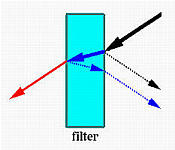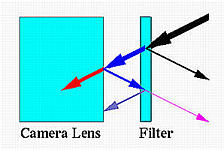When an incoming light ray hits a reflexive and transparent surface, some amount of this light ray will be refracted into the surface, some reflected off the surface, and some absorbed. When the refracted light reaches the second surface, another level of reflection and refraction occurs. Therefore, when a light ray passes through a single-glass filter, it is refracted twice and reflected twice, and its secondary ray (the reflected one by the internal surface) is also refracted once and reflected once. This process can go on indefinitely until the intensity of the n-th level ray is so weak that has no impact on the image. The first level and some second level rays are shown in the figures below.
 |
 |
Note that each reflection reduces the amount of light that can reach the camera lens. Moreover, reflections could also create flare and wash-out effect, and decrease contrast. To overcome this reflection problem, surfaces of all glasses of a modern lens are coated with layer(s) of scratch-resistant dioxide vapors. Sometimes, several layers of coating are applied to reduce reflection over a broad spectral range.
However, filters may not be coated; even they are coated, they may not be coated with multiple layers. In general, a multi-coated (MC) filter is more effective in reducing reflection than a mono-coated filter, which, in turn, is certainly better than a non-coated one.
There is an easy way to determine if a filter is coated. Hold a filter so that it can reflect the image of a light bulb. A non-coated filter should show the image in the original color of the light bulb. If a filter is coated, the reflected image should be tinted with a color different from the original. The following images illustrate the impact of coating on image quality. Each filter is placed at a location from where the incoming light can be reflected to the camera lens. The first one is a non-coated Skylight filter. The reflected light washes out the lower-left portion covered by the filter, and contrast is low. The upper-right image is a mono-coated UV filter, actually a B+W UV (010). Reflection is drastically reduced and contrast is improved. The lower-left image shows the effect of a multi-coated Skylight filter. Reflection is virtually gone, and the contrast is high except for the lower portion covered by the filter. Finally, the lower-right image shows a Nikon L1Bc (Skylight) filter with Nikon's Integrated Coating. There is no trace of reflection, and the contrast of the portion covered by the filter is almost identical to the other part. So, of these four filters, Nikon's L1Bc produces the best result. Here is a simple conclusion: In terms of reducing reflection, a multi-coated filter is better than a mono-coated filter, which, in turn, is better than a non-coated one!
|
|
|
| Not coated | Single Coating |
|
|
|
| Multiple coating | Nikon's Integrated Coating |
| Click on the image to see a larger one | |